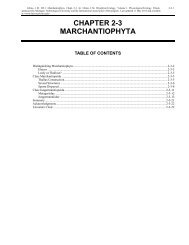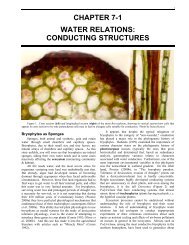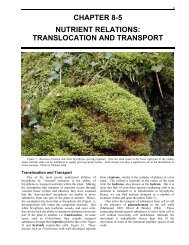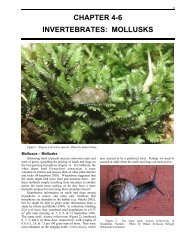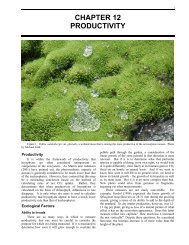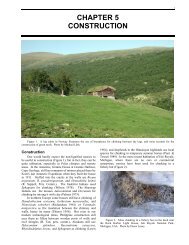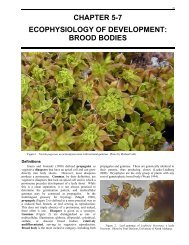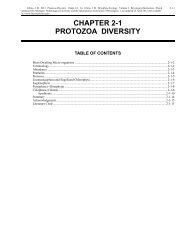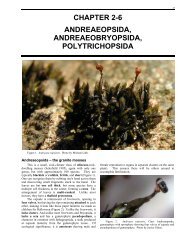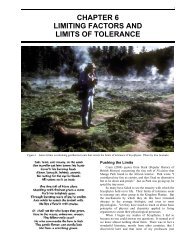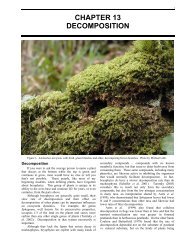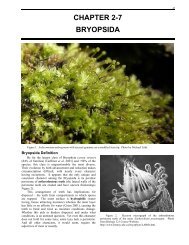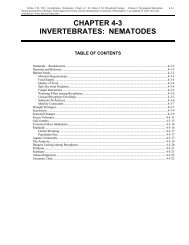Chapter 4-5 Invertebrates Rotifers - Bryophyte Ecology - Michigan ...
Chapter 4-5 Invertebrates Rotifers - Bryophyte Ecology - Michigan ...
Chapter 4-5 Invertebrates Rotifers - Bryophyte Ecology - Michigan ...
Create successful ePaper yourself
Turn your PDF publications into a flip-book with our unique Google optimized e-Paper software.
<strong>Chapter</strong> 4-5: <strong>Invertebrates</strong>: <strong>Rotifers</strong> 4-5-3example is the mostly planktonic genus Brachionus(Wikipedia 2011; Figure 4). In this genus, increases inpopulation density can induce sexual reproduction. Itappears that at least in Brachionus calyciflorus only oneallele is needed to turn off sexual reproduction and force allreproduction to be parthenogenetic. Brachionus urceolarislives among bryophytes (Figure 5; Hingley 1993).Among the pliomates (order Pliomida in the classMonogononta), two types of reproduction occur. In onetype, females produce unfertilized eggs that develop intofemales, just as in the bdelloids (Hingley 1993). But in thesecond type, sexual females appear only whenenvironmental conditions are unfavorable, such as droughtor cold. These females produce a sexual egg that forms athick-walled resting "egg" when fertilized. That restingegg develops into a female. If the egg is not fertilized, itdevelops into a male.Figure 2. Examples of bdelloid rotifers and mastax. Photosby Diego Fontaneto and Giulio Melone.Figure 4. Brachionus sp. (Monogononta) with three eggs.Note the tiny red eyespot that is sensitive to light. Photo by Jean-Marie Cavanihac at Micscape.Figure 3. Adineta vaga, a moss dweller that is 0.2-0.3 mmwhen extended. Photo by Jean-Marie Cavanihac at Micscape.In Lecane inermis, a Sphagnum dweller, micticfemales have the longest lives of 11.1 ± 0.28 days,followed by amictic females with a lifespan of 8.9 ± 0.11days, and the shortest lifespan in males at 5.7 ± 0.07 days(Miller 1931). In males, death of 83% of the populationoccurs within the fourth to sixth days. Females lay one eggevery 8.6 hours, whereas the amictic female lays one every7.5 hours. Amictic females usually die within 24-36 hoursafter laying the last egg, but among the mictic females, 19% live six more days.Gilbert and Schroder (2004) suggested that thediapause (resting) eggs that develop into amictic femalesin species like Polyarthra vulgaris, occasionally a mossdweller, may be an adaptation for survival in anenvironment that is unstable. These amictic females have ahigher lipid content, reduced digestive tract, and produce asingle large egg within hours of hatching, whereas thenormal generation time is six days. The diapause eggs areproduced by sexual reproduction of a female and smallmale, thus producing a diploid egg. Like many algae andother plants, this behavior of sexual reproduction occurswhen the environment becomes unfavorable. The diapauseegg is able to remain viable without hatching for extendedperiods of time.Figure 5. Brachionus sp. Photo by Jean-Marie Cavanihac atMicscape.The lifespan of many rotifers is typically 30-40 days,not counting their time in dormant states (Ricci 2001). Andspecies of these animals can often be found in active ordormant states on both aquatic/wetland (Priddle & Dartnall1978; Bateman & Davis 1980; Ricci 1983; Ricci et al.1989; Linhart et al. 2002) and terrestrial mosses (Bartos1949; Ramazotti 1958; Overgaard-Nielsen 1967; Kukhta etal. 1990). Several species are even known from the harshenvironment of mosses growing on roofs (Hirschfelder etal. 1993).



